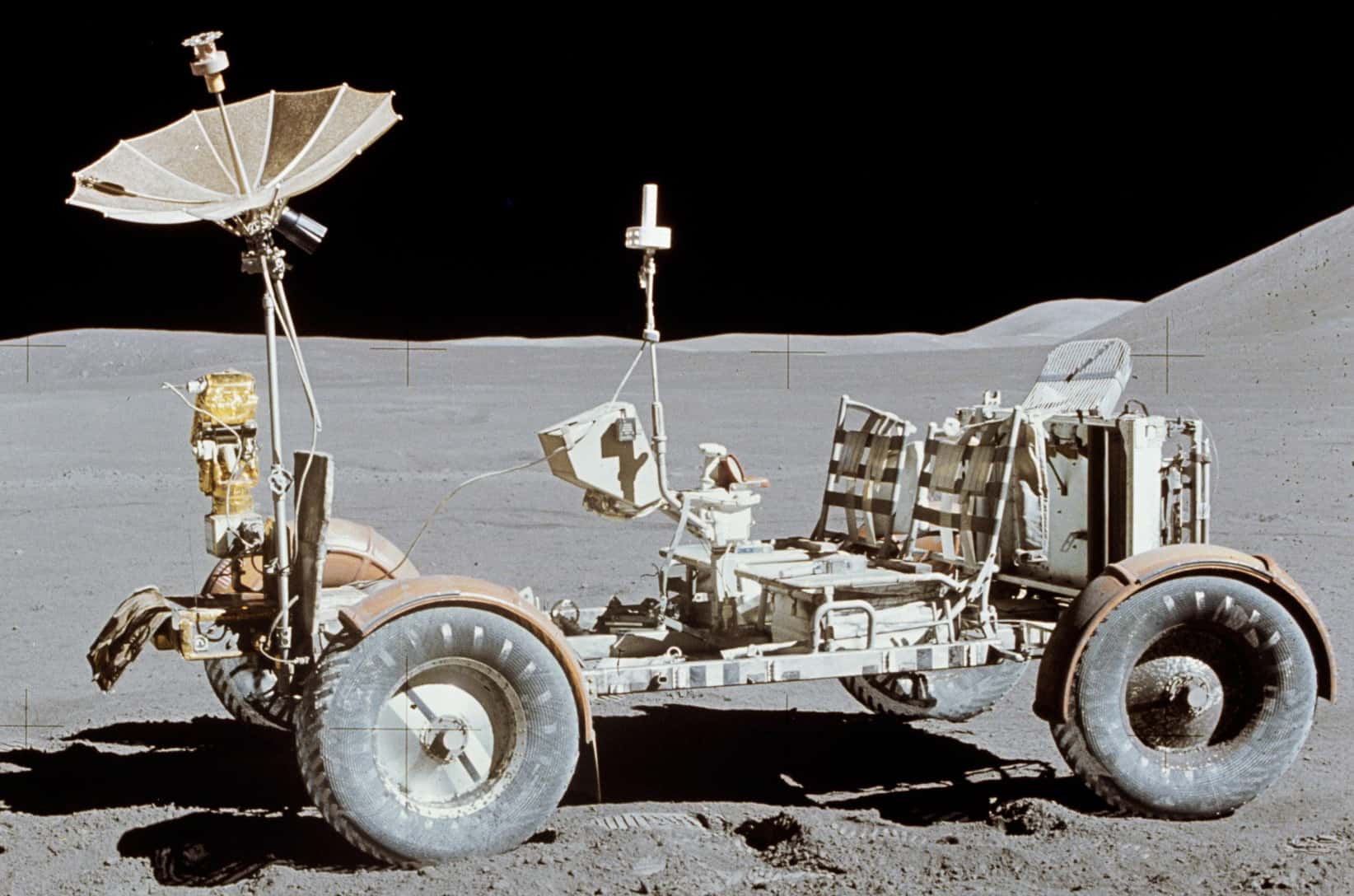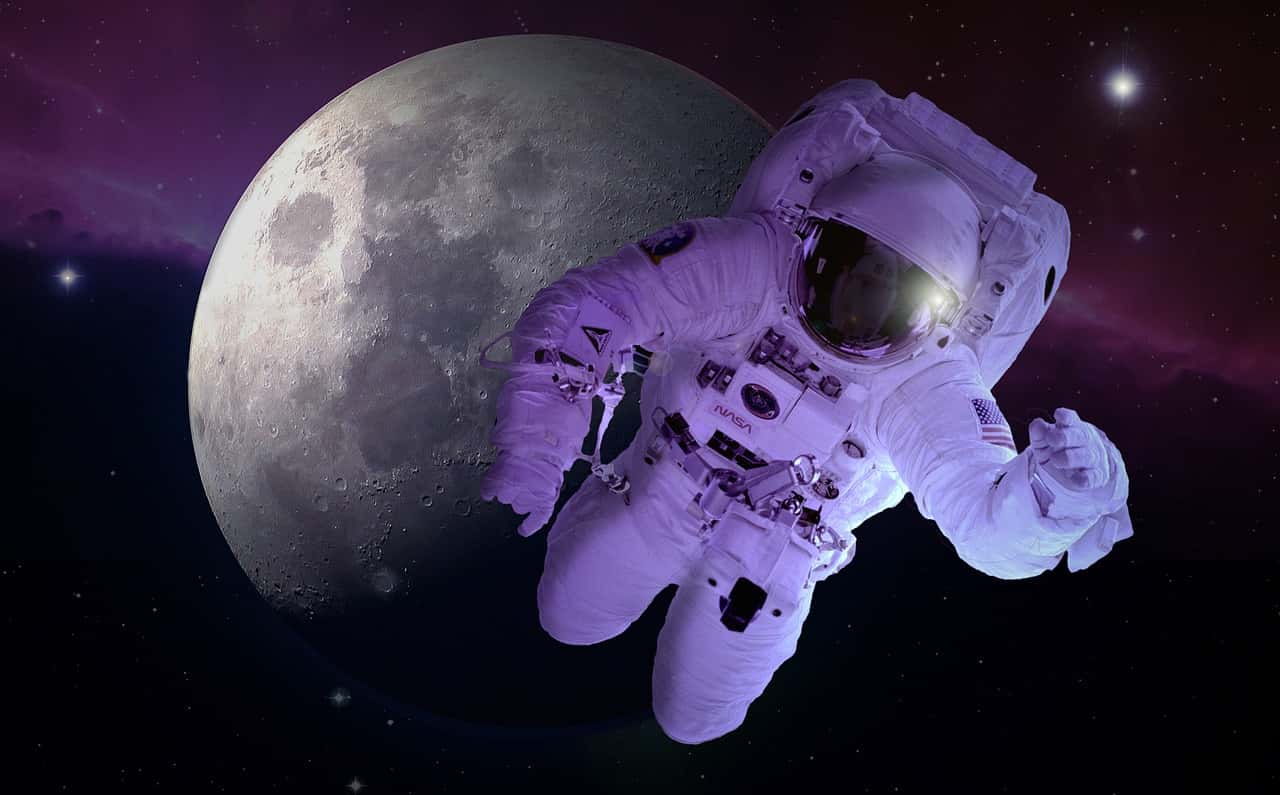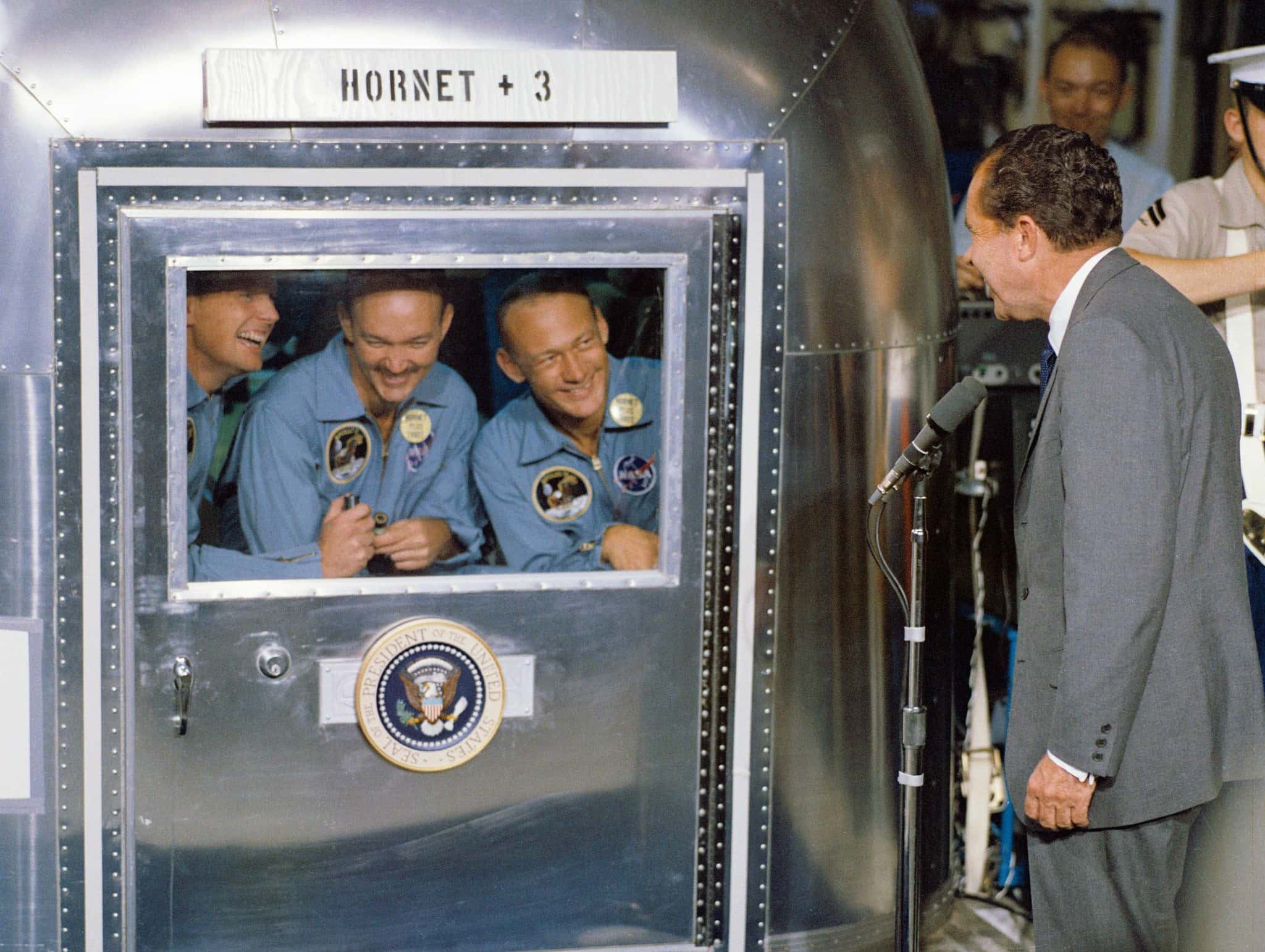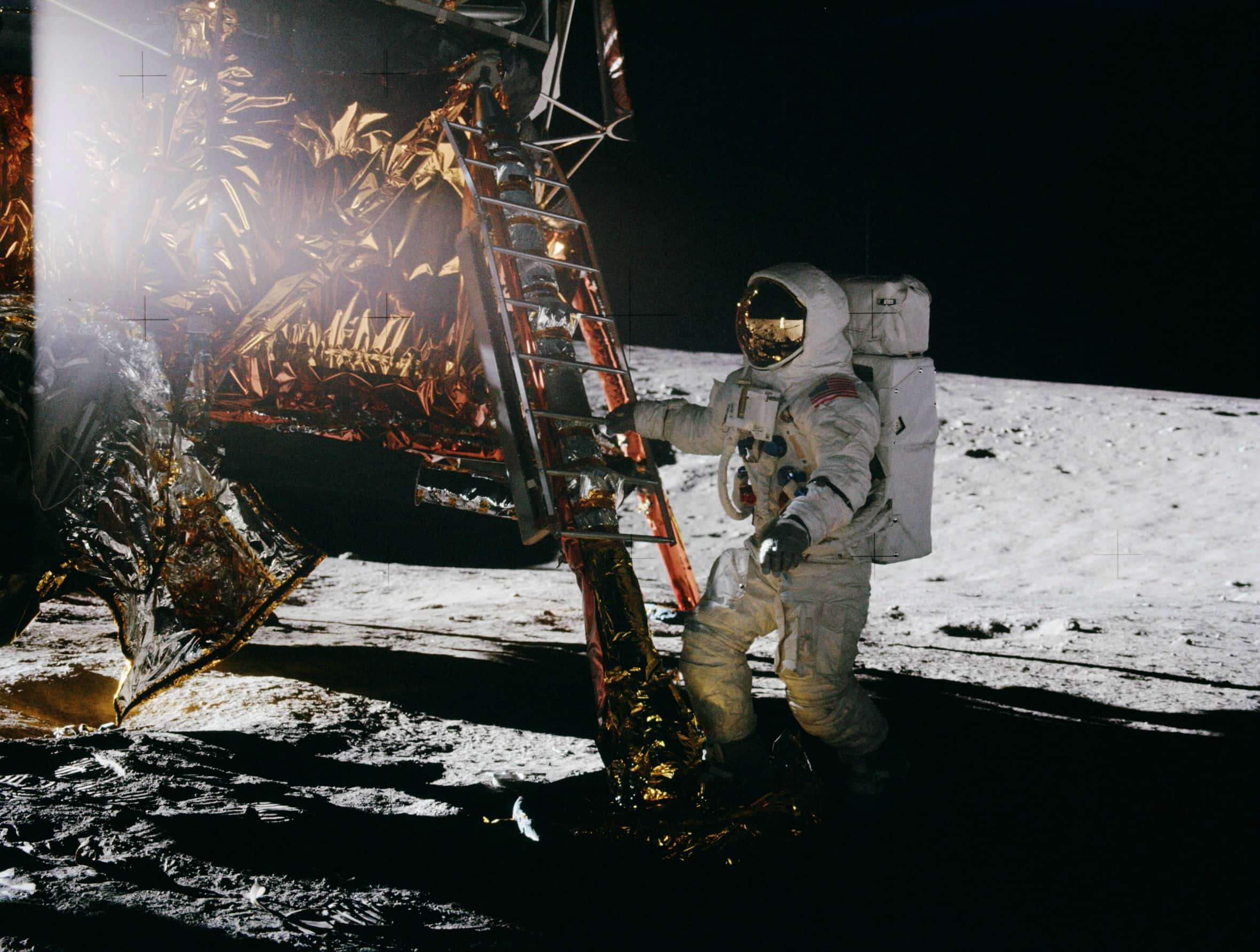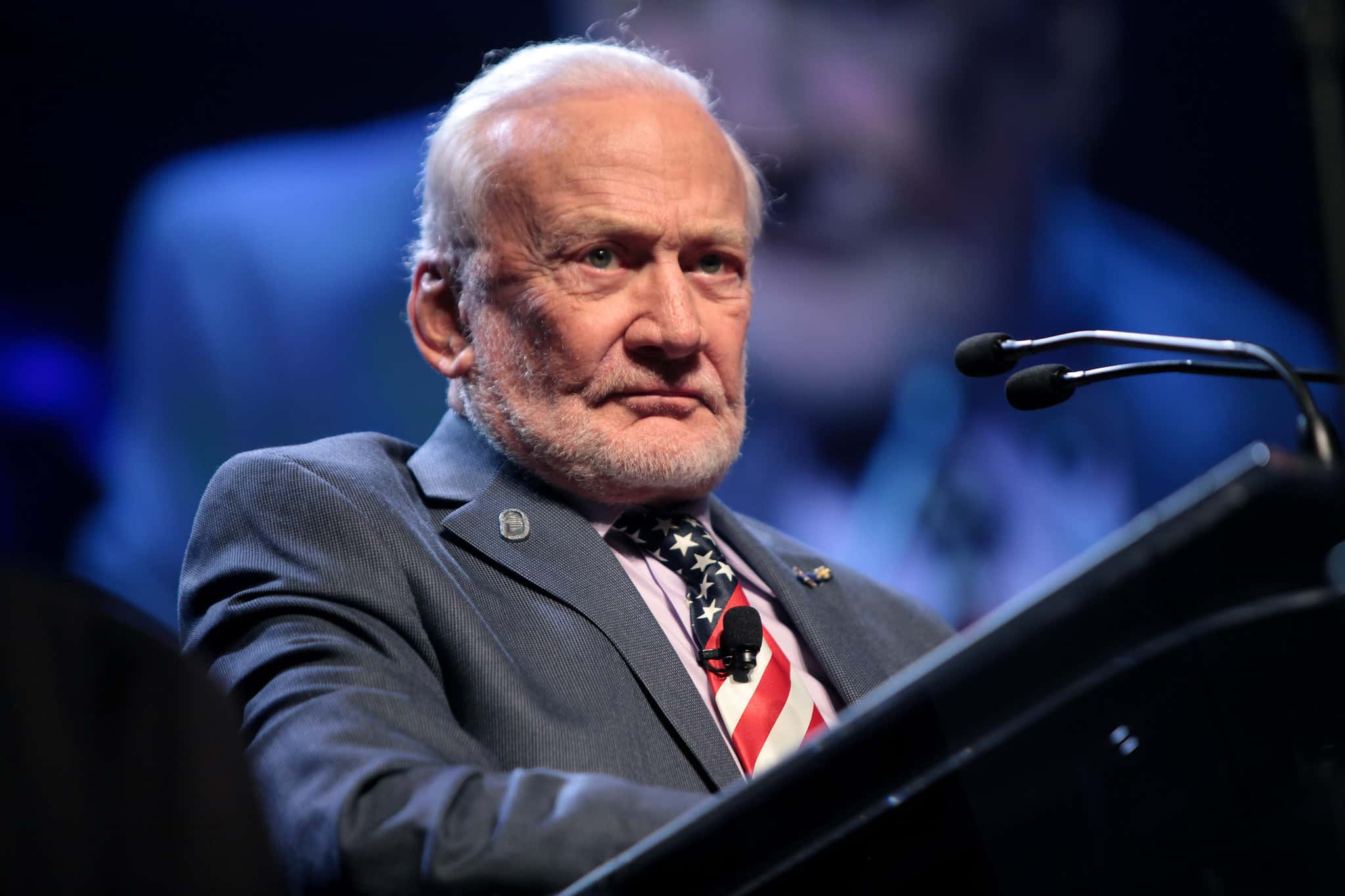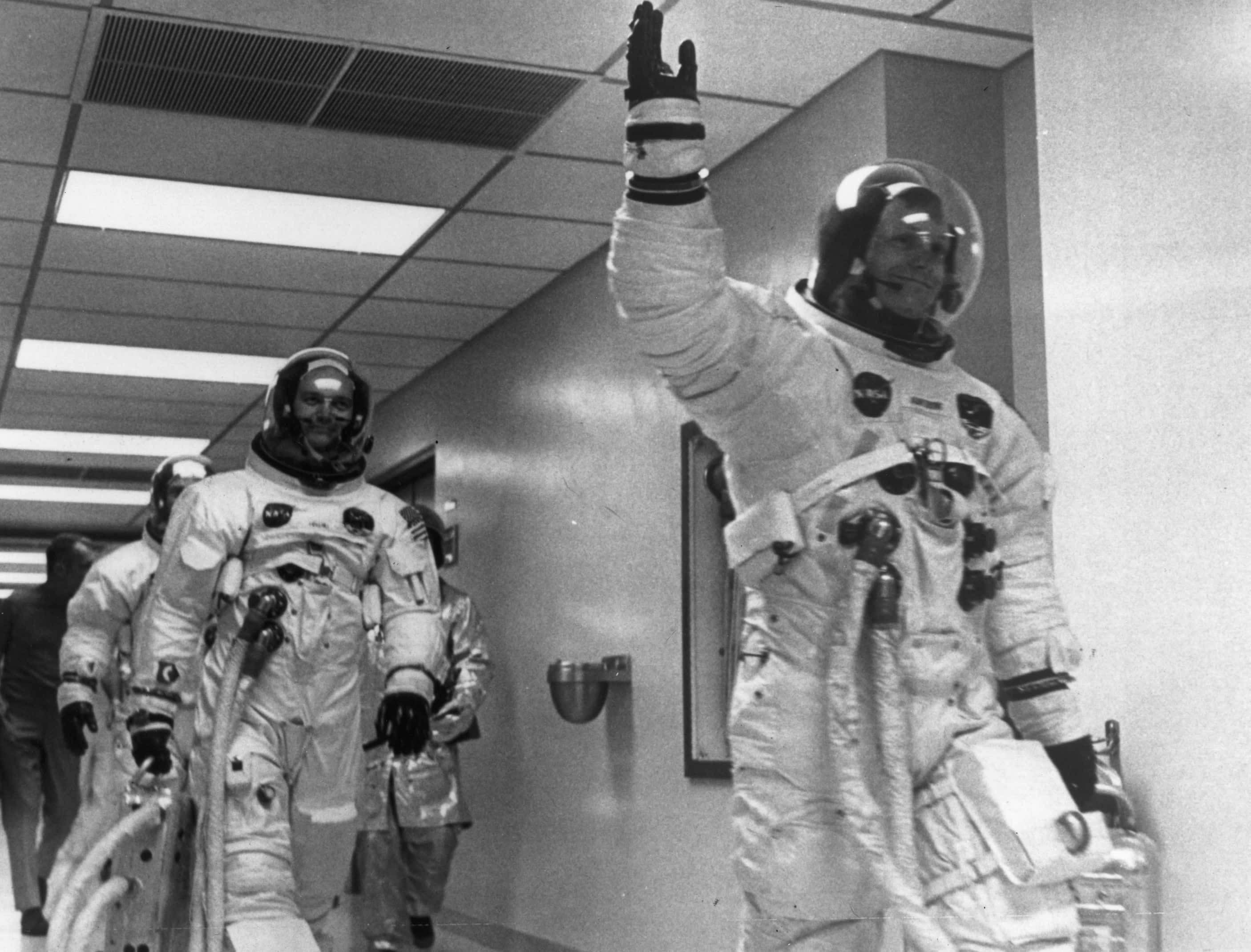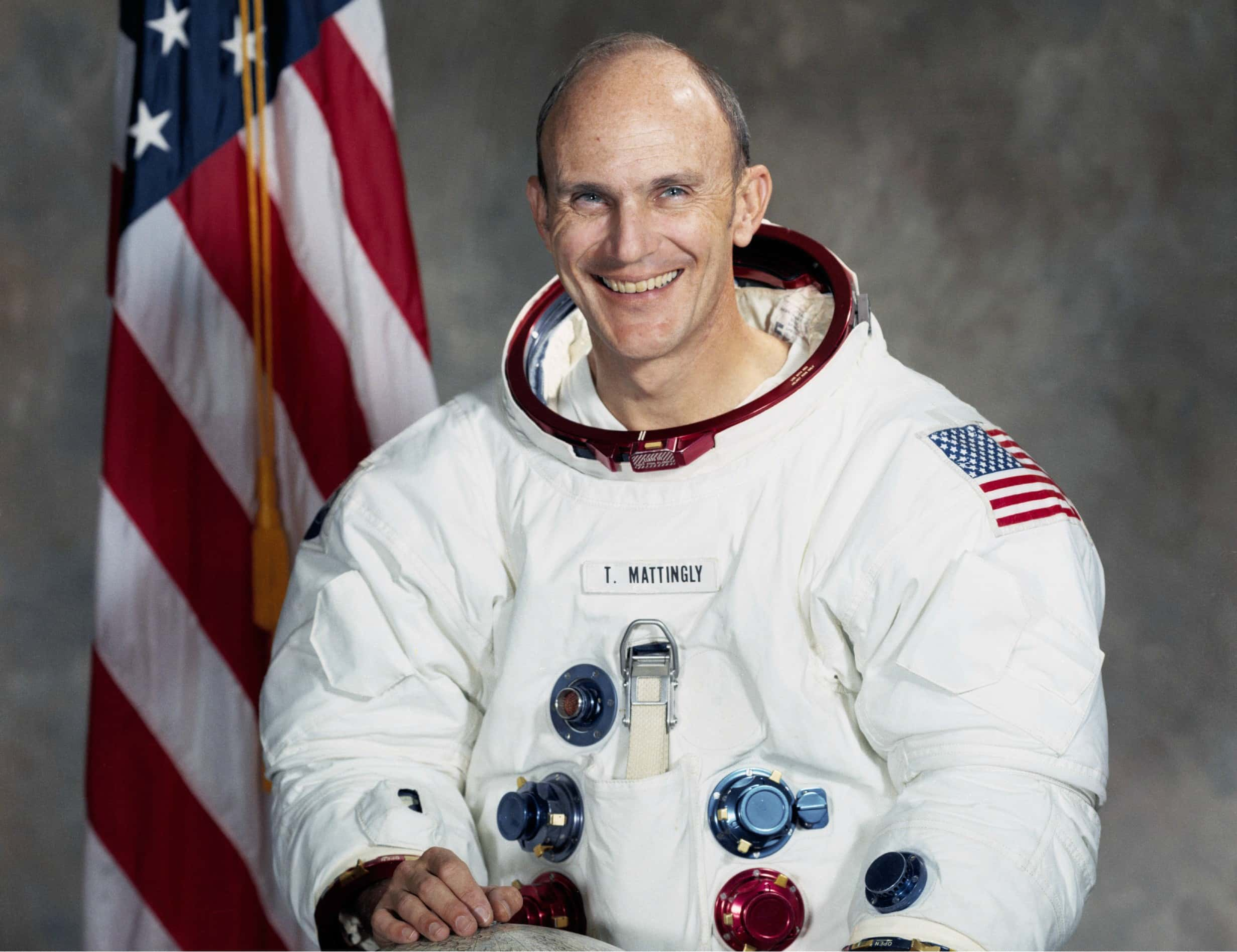“We choose to go to the Moon in this decade and do the other things, not because they are easy, but because they are hard."—John F. Kennedy
In 1969, eight years after Soviet cosmonaut Yuri Gargarin was the first person sent into space, the Apollo 11 mission landed on the moon and astronauts Neil Armstrong and Buzz Aldrin stepped out onto the speckled lunar surface. There were five more manned moon landings from 1969 to 1972, but there hasn’t been a person on the moon since. Read on to discover 42 cosmic facts about one of humanity's greatest triumphs.
Moon Landings Facts
42. Conspiracy Unbound
One of the most popular conspiracy theories out there is the idea that the 1969 Apollo 11 moon landing was faked. The theory, as put forward by the conspiracists, is that the landing was simulated using a Hollywood soundstage, professional actors, lighting, etc. Throwing cold water on this theory is the fact that, according to scientists, it would be have been harder to fake the moon landing in 1969 than it would have been to actually go there! Of course, the conspiracy theorists would argue that's what the scientists would say...
41. Moonquake!
Much like earthquakes, “moonquakes” are vibrations that can be felt on the surface of the moon. But, because the moon is dry and cool, and has a denser core than the earth (apparently similar to a large chunk of iron), moonquakes set the moon vibrating like a tuning fork!
40. What’s that Smell?
Have you ever wondered what space smells like? Or what the moon smells like? If you answered “a doctor’s office” or “cheese," prepare to be surprised. According to astronauts, space smells a lot like a NASCAR race—a bouquet of molten metal, diesel fumes and barbecue meat. This distinct smell is mostly the result of dying stars. The moon, for its part, apparently smells a lot like gunpowder after it's been fired.
39. Private Moon
Who owns the moon? According to the 1979 “Moon Treaty” that was adopted by the United Nations and signed by member nations, the moon and its natural resources are the “common heritage of mankind” and resources may only be harvested under an international regime overseen by the UN. The only problem is that the all of the countries with major active space programs—Russia, the US and China—have refused to sign, ratify or accede to the treaty.
38. Counterfeit Rock
The Dutch National Rijksmuseum has a moon rock in its possession that was given as a gift to a former Dutch Prime Minister by the US Ambassador. The rock reportedly came from the Apollo 11 mission and was insured by the museum for approximately half a million dollars. The only problem is that, in 2006, tests revealed that the rock was actually a piece of petrified wood, and it's probably worth about 70 bucks. Whoopee.
37. Astronauts of Anarchy
Astronauts cruising the lunar surface on Harley Davidsons? Crazy it may sound, NASA almost sent motorcycles to the moon instead of the lunar rover. NASA built prototypes of electric motorcycles and tested them out in zero gravity circumstances as a back-up in case the newly developed lunar rover was not ready in time for the Apollo 15 mission. As the lunar rover did end up being ready, the motorcycles ended up being a small footnote in NASA lore.
36. Metric Concession
NASA intends to return astronauts to the moon by the year 2020. And when they do, they have agreed to begin using metric units. While this may seem like a small concession, this international agreement was years in the making. The main purpose for using metric units was in order to standardize measurements across all space agencies (all of which already use metric units, aside from the US) as a means of ensuring effective cooperation amongst the different agencies.
35. Regretful Editorial
In 1920, rocketry pioneer Robert W. Goddard argued his multi-stage rockets would be able to one day travel to the moon and even far-away planets. The New York Times in an editorial ridiculed Goddard’s lunar optimism, as well as his understanding of basic physics, stating that the idea that a rocket may someday be able to traverse the vacuum of space would “deny a fundamental law of dynamics.” The editorial piled on, adding that Goddard “seems to lack the knowledge ladled out daily in highs schools.” For its part, the newspaper issued a joking retraction of this editorial in 1969 as the Apollo 11 geared up to fly and land on the moon.
34. Moon Comrades
During height of the Cold War, Neil Armstrong’s final task on the moon was to leave a small package of items honoring former Soviet cosmonauts, including Vladimir Komarov (the first person to die during space travel) and Yuri Gagarin (the first person in space).

History's most fascinating stories and darkest secrets, delivered to your inbox daily.
33. Call of the Moon
Beginning in the early 1980s, there was a popular hoax going around in many Middle Eastern countries that Neil Armstrong had heard the Muslim call to prayer while walking on the moon and had subsequently converted to Islam. In 1983, the US State Department went as far as to issue a message to Muslims around the globe that the story was fake and that Armstrong had not, in fact, converted to Islam.
 Pixabay
Pixabay
32. Taped Over
NASA’s original raw tapes of the moon landing by the Apollo 11 mission were unwittingly taped over in the early 1980s. In the late 2000s, following a long search and investigation into the “missing tapes,” the truth was revealed. For their part, NASA claimed that re-using tapes was standard procedure at the time as backup video was not deemed as important and the agency faced a major shortage of data tapes.
31. We Reluctantly Agree to Not Nuke the Moon
In 1967, the US and the Soviet Union signed a treaty that prohibited them from testing nuclear weapons on the moon.
30. Goodnight Moon
As unnecessary as the “please-don’t-blow-up-the-moon treaty” may sound, the United States had an actual plan to do just that during the Cold War, or at least to detonate nuclear bombs up there. The US formed a top-secret project in 1958 to research nuking the moon, with one of the major objectives being a “show of force” towards the Soviet Union, who had taken an early lead in the Space Race. The test would also serve as a “morale boost” for the US public. Thankfully, the program was scrapped and the moon survived intact.
29. Dangerous Dust
Moon dust, described as “fine as flour and rough as sandpaper,” has caused unforeseen problems for astronauts who’ve roamed across the lunar surface. The abrasive dust can reportedly wear through layers of kevlar, cling to space suits and equipment, and give astronauts cases of "lunar hay fever" if the dust is inhaled.
28. Taking Out the Trash
One of the first things Neil Armstrong did after stepping onto the surface of the moon was throw a bag of trash onto the ground and kick it under the lander. In fact, the white bag of trash can be seen in the foreground of Armstrong’s first ever photo taken on the moon.
27. Waving the White Flag
All of the flags that various NASA astronauts have placed on the moon are still standing, according to lunar imaging. But lunar scientists believe that the flags have now been bleached completely white by the constant, unfiltered solar radiation present on the moon’s surface.
26. Fly Me to the Moon
Inside Neil Armstrong’s space suit pocket when he walked on the moon was another piece of 20th century aeronautical history. Namely, a piece of fabric from the original 1903 Wright Flyer, along with a piece of wood from the aeroplane’s propeller.
25. Heavenly Mass
The asteroid belt—a concentrated zone of asteroids located in between Mars and Jupiter—is estimated to contain millions of asteroids. The belt also includes a dwarf planet, Ceres, which is 100km across. Nevertheless, the moon’s mass is still twenty times greater than the total mass of all the asteroids in the asteroid belt combined.
24. Moon Boots
Neil Armstrong’s moon boots are still on the moon, and it’s not because he accidentally forgot them there. Nine pairs of astronaut boots still sit on the moon's surface, having been jettisoned purposely in order to compensate for the additional weight brought back by collecting moon rocks. Scientists believe that as a result of sitting on the moon for over four decades, if one attempted to pick up the boots today, they would likely turn to powder immediately upon being touched.
23. Youth Movement
Apollo 11 was a youth endeavor. The NASA employees who first put a man on the moon were largely recent graduates—beneficiaries of significant investments made by the government in the US education and research system following the launch of Sputnik by the Soviet Union. In fact, the average age of Apollo 11’s mission control team was only 28 years old.
22. Friends to the Moon and Back
In 1963, President John F. Kennedy proposed that the US and the Soviet Union cooperate and form a joint mission to land on the moon. Soviet leader Nikita Khrushchev initially rejected Kennedy’s proposal, but subsequently wavered and was ready to accept it right before Kennedy was assassinated. As Khrushchev didn’t trust Kennedy’s successor, Lyndon Johnson, the proposal never ended being taken up by the Soviets, and the Americans landed first.
21. Mission Unpopular
While it seems as if it would be universally popular today, throughout the 1960s a majority of Americans were actually opposed to the US government’s moon mission. Some criticized the fact that the government had the money to invest in sending people to space while pressing economic and social issues deserving of that investment existed at home. Even the majority of scientists were opposed to the program at the time, arguing that earthly scientific endeavors needed attention and funding instead.
20. Knocked Out of Orbit
In 2002 Buzz Aldrin, the second man on the moon, was lured to a Beverly Hills hotel on the pretext that he was being interviewed for a Japanese children’s TV show. Instead, he was ambushed by a conspiracy theorist with a camera crew who accused Aldrin of faking the moon landings. The conspiracy theorist berated Aldrin, calling him a “coward and liar,” before Aldrin swiftly punched him in the jaw (a memorable moment that was captured by the conspiracy theorist’s cameras).
19. Moon Mirrors
Apollo 11, 14 and 15 missions left an array of mirrors on the moon, which scientists can bounce lasers off of in order to accurately measure the distance between the moon and the earth. The results of these measurements have confirmed what should be expected if Einstein’s general theory of relativity is correct, as well as showing that the moon is slowly spiralling away from the earth at a rate of 3.8 cm per year.
18. Just Dropping In
Neil Armstrong and Buzz Aldrin stayed on the moon for just 21 hours total—only two-and-a-half hours of which was spent outside the lunar module on the moon’s surface exploring, doing experiments, and collecting samples.
17. It Was Written
Buzz Aldrin’s mother’s maiden name was Moon.
16. Gravity Confirmed
Astronaut David Scott dropped a feather and a hammer at the same time while on the moon, repeating Galileo’s famous experiment in a vacuum environment. For the record, just as on earth, both objects landed at the exact same time.
15. Stranded on the Moon
A special speech entitled “In Event of Moon Disaster” was prepared for President Richard Nixon to read out in the event that the astronauts of Apollo 11 were stranded on the moon and unable to make it back to earth. NASA mission control would cut off communication and a clergyman would "commend their souls to the deepest of the deep" in a ritual likened to burial at sea.
14. Technical Difficulties
During the Apollo 12 mission, astronaut Allan Bean destroyed the mission’s color camera by inadvertently pointing it directly at the sun. This immediately ended the TV transmission of the second lunar landing.
13. Astronomy Badge
11 of the 12 people to walk on the moon were boy scouts. This is not an anomaly—reportedly more than two-thirds of all astronauts have been involved in scouting.
12. Secret Communion
After landing on the moon—but before he stepped out onto the lunar surface—Buzz Aldrin secretly took communion. At the time, NASA was the subject of a lawsuit brought by an atheist who objected to the broadcast of religious activities by astronauts while in space (Apollo 8 read from the Book of Genesis). As such, Aldrin refrained from broadcasting his religious ritual.
11. Dark Side of the Moon
Shortly after returning from the moon as a hero, Buzz Aldrin’s life fell apart. He left NASA for a failed career as a test-pilot commander, divorced his childhood sweetheart, quickly remarried and divorced again within two years, fell into a deep depression, suffered from alcoholism, and eventually ended up working at a Cadillac Dealership in Beverly Hills where he failed to sell a single car in six months. Aldrin stated that, after leaving NASA, "For the first time in more than 40 years I had no one to tell me what to do, no one sending me on a mission. Rather than feeling an exuberant sense of freedom, I felt isolated, alone and uncertain.”
10. Low Tech
The Apollo 11 mission astronauts navigated space with a computer that had less memory than a modern cell phone.
9. The Truth is Out There
Only 12 people have walked on the moon. One of those twelve is astronaut Edgar Mitchell (the sixth person to achieve the distinction), who insists that a cabal of government insiders is covering up alien visitations to earth and the existence of alien bodies in places such as Roswell, New Mexico.
8. Missing Rocks
Of the 270 moon rocks that have been gifted over the years, over 180 of them are unaccounted for. Moon rocks have frequently been the subject of theft and misappropriation as well as counterfeiting.
7. Third Time’s The Charm
The third person on the moon was an astronaut named Peter Conrad. Conrad commanded Apollo 12 in late 1969, the second Apollo Mission to land on the moon. Joking about his reduced standing as the third person on the moon, Conrad yelled out: “Whoopee! Man, that may have been a small one for Neil, but that's a long one for me.”
6. Astronauts Unscripted
Before he took off, Conrad made a $500 bet with an Italian journalist that thought Armstrong's famous "giant leap for mankind" line was scripted. To prove that NASA did not script astronaut comments, Conrad’s first words when he stepped onto the lunar surface were “Oooh, is that soft and queasy.”
5. When Can I Expect Reimbursement?
Just as if he was going on any other work-related travel, Buzz Aldrin made an itemized expense form for his trip to the moon. The form lists his travel from Houston to Cape Kennedy to the moon to splashdown in the Pacific Ocean and then back to Houston. Expenses claimed amounted to $33.31.
4. Space Virus
Following their splashdown to earth, the Apollo 11 astronauts were required to spend a full 21 days in medical quarantine. This measure was put in place in order to prevent any unknown moon-based contagion on earth. This measure continued for other missions, before being dropped after the Apollo 14 mission, when it was decided that the moon was so barren of any life that the measure was unnecessary.
3. Anything to Declare?
Aldrin and Armstrong had to go back through customs and immigration after they returned from the moon. Arriving in Hawaii after being picked up following their splashdown in the Pacific Ocean, the astronauts declared that they had only brought back “moon rocks and moon dust samples.”
2. Lost Ring
On the second day of his 11-day trip to the moon and back, astronaut Ken Mattingly inadvertently lost his wedding ring. Mattingly spent all of his free moments desperately searching for the ring in the spacecraft as well as on the surface of the moon. Finally, on the ninth day, Mattingly happened to spot the ring floating out the open hatch of the spacecraft while performing a space walk and managed to grab it before it floated away. Hopefully he hangs onto it this time!
1. A Small Misquote For Man
Most think they know what Neil Armstrong said when he stepped foot onto the moon, but both NASA and Armstrong himself claim otherwise. The common perception of what Armstrong said is: “That’s one small step for man; one giant leap for mankind.” But NASA and Armstrong, since the very beginning, have insisted that he said “one small step for a man.” In 2013, researchers conducted an intense audio analysis of the Armstrong recording and vindicated the trailblazing astronaut by concluding that it is possible that, after all these years, this is in fact exactly what Armstrong said.
Sources: 1, 2, 3, 4, 5, 6, 7, 8, 9, 10, 11, 12, 13, 14, 15, 16, 17, 18, 19, 20, 21, 22, 23, 24, 25, 26, 27, 28, 29, 30, 31, 32, 33, 34, 35, 36, 37, 38, 39







